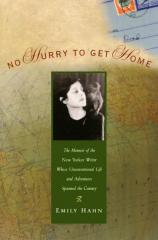No Hurry to Get Home: The Memoir of the New Yorker Emily Hahn Whose Unconventional Life and Adventures Spanned the 20th Century
Review
No Hurry to Get Home: The Memoir of the New Yorker Emily Hahn Whose Unconventional Life and Adventures Spanned the 20th Century
![]() At the young age of 24, author Emily Hahn began her professional writing career working for the popular magazine The New Yorker. She continued to publish work throughout the years, and made her final contribution a year before her death in 1996. NO HURRY TO GET HOME is a memoir containing bits and pieces of her extraordinary life. Originally published as TIMES AND PLACES, NO HURRY TO GET HOME contains short stories that were written for The New Yorker. The stories take us back to her early days as a child growing up in St. Louis and Chicago, through to her travels abroad.
At the young age of 24, author Emily Hahn began her professional writing career working for the popular magazine The New Yorker. She continued to publish work throughout the years, and made her final contribution a year before her death in 1996. NO HURRY TO GET HOME is a memoir containing bits and pieces of her extraordinary life. Originally published as TIMES AND PLACES, NO HURRY TO GET HOME contains short stories that were written for The New Yorker. The stories take us back to her early days as a child growing up in St. Louis and Chicago, through to her travels abroad.
In the introduction, Ken Cuthbertson summarizes Hahn's life. Born on January 14, 1905, in St. Louis, Missouri, she was the fifth of six children. By the time she had turned three, Hahn had already learned how to read. While living in Chicago, she began to write down her thoughts and emotions on a regular basis. After high school, Hahn earned a degree from the University of Wisconsin's school of mining engineering --- she was the first woman to ever do so. As an adult, she lived a very adventurous life, sometimes flirting with death and danger. While living in New York City, she almost died by overdosing on sleeping pills. In yet another instance, she could have been killed when she was caught in a Japanese air raid on the Chinese city of Chungking in 1940. NO HURRY TO GET HOME captures the adventurous drive and spirit of this talented young woman.
In the first short story, "The Escape," I began to see that Hahn was different from most girls her age. Struggling with a recent move from St. Louis to Chicago, she decides that she will run away from home. She brings to life so many of the issues young women deal with while growing up. Her mother strongly disapproved of boys in her life -- she thought the act of chasing a boy was the worst thing a young woman could do. Hahn felt anger and frustration at having been uprooted from everything familiar to her when the family made the move to Chicago. On top of this, her mother constantly criticized her decisions. The thing that made Hahn different from most girls her age was her strong display of independence. She was determined to seek out the things in life that interested her.
Throughout the book, each story provides a touching glimpse into Hahn's life. While some of the stories focus on her younger years, many of the stories involve her as a parent. It's great how she makes this connection from young to old. It's as though I've heard some of these stories before, in my own life. She reflects on her first visit to the West, and her life in New Mexico. She describes the emotions of being a traveler in a foreign country, far from home. The lonely and sometimes confusing thoughts we each experience at some point in our lives. The most important image NO HURRY TO GET HOME brings to my mind is the image of strength and independence. In a day and age when most women were expected to live a life in the confines of a home, Hahn experienced the world. She faced many obstacles, and never gave in the to challenge. Her drive for experience and knowledge was unstoppable. Hahn was not only a writer, she was an adventurer, in a place, few of us have ever dared to go.
Reviewed by Jonathan Lamas (jonlamas@aol.com) on November 1, 2000
No Hurry to Get Home: The Memoir of the New Yorker Emily Hahn Whose Unconventional Life and Adventures Spanned the 20th Century
- Publication Date: November 1, 2000
- Genres: Nonfiction
- Paperback: 312 pages
- Publisher: Seal Press
- ISBN-10: 158005045X
- ISBN-13: 9781580050456



